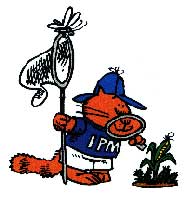 Weed, insect and disease problems of corn, soybeans,
small grains and alfalfa will be covered during the
integrated pest management training school at the
University of Kentucky Research and Education Center in
Princeton March 19th.
Weed, insect and disease problems of corn, soybeans,
small grains and alfalfa will be covered during the
integrated pest management training school at the
University of Kentucky Research and Education Center in
Princeton March 19th.

The 2003 Field Crops and Livestock Insecticide Recommendations are available. You can select crop or livestock pests from appropriate menus. You will get graphics, scouting information, decision guides, and recommended pesticides.
There are links to publications and fact sheets. Newly
registered products will be placed here as appropriate.
Bookmark it and use it often.
See "Insect Management Recommendations" for insecticide recommendations on crops and livestock.
 Weed, insect and disease problems of corn, soybeans,
small grains and alfalfa will be covered during the
integrated pest management training school at the
University of Kentucky Research and Education Center in
Princeton March 19th.
Weed, insect and disease problems of corn, soybeans,
small grains and alfalfa will be covered during the
integrated pest management training school at the
University of Kentucky Research and Education Center in
Princeton March 19th.
Registration will begin at 8:30 a.m. The program begins at 9 a.m. and ends at 4 p.m. It is open to the public and free of charge. Advance registration is not needed. An update of pest problems in Kentucky will include soybean stem borer, soybean rust and pesticide resistant pests.
The program has been approved for 5.5 continuing education credits for certified crop advisors in the areas of pest management, 3 hours; crop management, 2 hours; and soil and water management, 0.5 hours. The program has also been approved for 3 general and 2 specific hours for Pesticide Applicator Training certification for categories 1, agriculture applicator; 10, demonstration and research; and 12, retail pesticide sales agent (dealer) for Kentucky Pesticide Applicator Training.
For additional information contact Patty Lucas at (270)
365-7541 ext. 218 or
plucas@uky.edu.
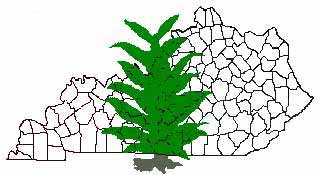
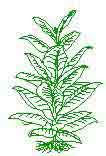 [I strongly urge all with tobacco interest to read the article by Dr.
John Hartman in this issue related to Greenhouse Geraniums.
Proper handling of this geranium situation is also important to
the state's tobacco industry.]
[I strongly urge all with tobacco interest to read the article by Dr.
John Hartman in this issue related to Greenhouse Geraniums.
Proper handling of this geranium situation is also important to
the state's tobacco industry.]
For the latest blue mold status and other tobacco disease information, check the KY Blue Mold Warning System.
![]() http://www.uky.edu/Agriculture/kpn/kyblue/kyblue.htm
http://www.uky.edu/Agriculture/kpn/kyblue/kyblue.htm
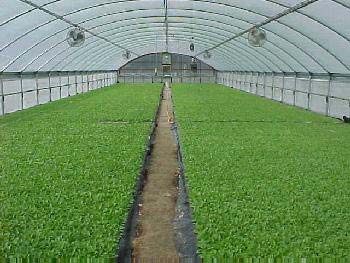 Terramaster 4EC, etridiazole (terrazole), marketed by Crompton
Uniroyal Chemical Co. last year received a federal label for
Pythium control in tobacco float-beds (greenhouse or outdoor
float-bed systems). The use pattern for this product was recently
modified, mainly as lower rates in the preventative uses
category.
Terramaster 4EC, etridiazole (terrazole), marketed by Crompton
Uniroyal Chemical Co. last year received a federal label for
Pythium control in tobacco float-beds (greenhouse or outdoor
float-bed systems). The use pattern for this product was recently
modified, mainly as lower rates in the preventative uses
category.
The changed uses are as follows:
*As a preventative treatment, use Terramaster 4EC at 0.7 fluid oz/100 gallons of float-bed water, no sooner than three weeks after seeding. Supplemental preventative applications can be made at 0.7 fl.oz/100 gallons of float-water 3 weeks after the first application, with a third and final application 2 weeks after the second. This is a lower rate than the previously labeled rate and will provide slightly less control than the higher rate but has significantly less phytotoxicity potential.
* As a curative treatment Terramaster 4 EC can be used when symptoms first develop but no sooner than three weeks after seeding and with leaves at least one inch in diameter. This rate is 1.4 fl. oz/100 gallons of float-water and one additional curative application can be made (if symptoms return) at 1 to 1.4 fl. oz/100 gallons of float-water.
There is a limit of 2.8 fl.oz/100 gallons of float-water per bed (crop of plants)/season. No applications can be made later than 8 weeks after seeding.
Some phytotoxicity symptoms should be expected with this
product, but when used correctly the level of phytotoxicity
should be acceptable compared to the damage Pythium can
cause. However, it is essential that Terramaster 4EC be evenly
distributed throughout the float-bed water. The label gives good
directions on how to achieve this within the bay, by mixing the
product outside the treated bay then delivery of the diluted
product uniformly into the bays. In our studies, we have
observed significantly higher phytotoxicity when studies were
conducted in water naturally high in pH (above 7.0) than in
waters naturally low in pH (less than 6.3).
See "Insect Management Recommendations" for for insecticide recommendations on tobacco and other crops and livestock.
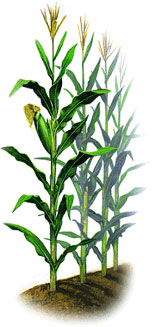
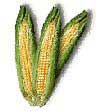 Questions about managing Star-of-Bethlehem in crops have
already started and will likely continue for the next several
weeks. This weed is sometimes referred to as snowdrops and is
a perennial that is related to wild garlic.
Questions about managing Star-of-Bethlehem in crops have
already started and will likely continue for the next several
weeks. This weed is sometimes referred to as snowdrops and is
a perennial that is related to wild garlic.
Star-of-Bethlehem does not have the garlic odor. It is often identified by its slender succulent leaves that have a wide midrib, compared with garlic that has round hollow leaves. Star-of-Bethlehem usually begins to emerge early in February while wild garlic can emerge in the fall through early spring. Star-of-Bethlehem has an aggressive growth habit initially, but dies back in late April - May.
Burndown in No-till Corn or Soybeans: Star-of-Bethlehem often occurs as numerous plants that form a dense cover. This mat of succulent growth can be a difficult environment in which to plant no-till corn or soybeans.
Although there are no herbicides labeled for controlling Star-of- Bethlehem in grain crops, there may be some options that provide top growth kill or suppression. This is one of the few perennial weeds where Gramoxone Max (paraquat) may be preferred over glyphosate as a burndown option. Some growers have had reasonably good success in burndown dessication of top growth of Star-of-Bethlehem with this herbicide. Research by Dr. Brian Young at Southern Illinois University confirmed that Gramoxone Max was effective in managing top growth of Star-of-Bethlehem. He also observed that Valor (flumioxazin) and Authority (sulfentrazone) provided control that was similar to that observed with Gramoxone Max. It is not clear that these herbicides will contribute to the long- term control of underground bulbs.
Wheat: Herbicides currently used in wheat do not offer consistent control of Star-of-Bethlehem . Harmony Extra applied at the high rate of 0.6 oz/A may suppress this weed, but results are often variable. Fortunately, the period of competition in wheat is short, consequently a uniform dense stand of wheat often survives with minimal affects from Star-of- Bethlehem.
For more information about corn pests, visit "Insect Management Recommendations".
 Because of low profitability of soybeans, quite a few Kentucky
producers who normally rotate corn with soybeans or
wheat/double-crop soybeans are planting back-to-back corn. As
Dr. Ric Bessin reported in Kentucky Pest News several weeks ago,
I am hearing reports of producers moving from 50/50 splits
with corn/rotation crop to 60/40, 70/30, and even 80/20 splits,
resulting in quite a bit more continuous corn than we have had
in Kentucky previously.
Because of low profitability of soybeans, quite a few Kentucky
producers who normally rotate corn with soybeans or
wheat/double-crop soybeans are planting back-to-back corn. As
Dr. Ric Bessin reported in Kentucky Pest News several weeks ago,
I am hearing reports of producers moving from 50/50 splits
with corn/rotation crop to 60/40, 70/30, and even 80/20 splits,
resulting in quite a bit more continuous corn than we have had
in Kentucky previously.
A disease of serious concern in back-to-back corn is gray leaf spot, especially under conservation tillage systems. The fungus that causes gray leaf spot attacks corn almost exclusively; it survives in corn leaves; and it spreads in air currents. Thus, expect pressure from this disease to increase in continuous corn. Producers need to select hybrids with as high a resistance as possible, especially under conservation tillage. Fortunately, many hybrids are available with partial resistance to this disease. Note that this is partial resistance. One will still see disease develop with these hybrids, just not as much as in fully susceptible hybrids. If weather conditions favor this disease, I expect it to be a potential problem on every farm with continuous corn, but more of a problem on those conservation tillage and landscapes prone to foggy mornings.
Another disease of concern in continuous corn is Diplodia ear rot. Like the gray leaf spot fungus, the fungus that causes this ear rot attacks essentially corn only and it survives in corn residue. The spores are spread by rainsplash, so they tend not to move very far, and it might take a few years for a serious problem to develop in many fields. However, some corn hybrids are very susceptible to this disease, and infections by Diplodia ear rot commonly consume the entire ear. Thus, if Diplodia pressure has built up in a field and weather conditions favor infection around silking, then susceptible hybrids can be badly diseased, affecting up to 75-80% of the ears in a field in the worst outbreaks. This is not a disease to be casual about. One should scout fields of continuous corn carefully before harvest for Diplodia ear rot. If 2-3% or more of the ears are diseased from Diplodia, either rotate away from corn or select a hybrid with a rather high level of Diplodia ear rot resistance. Unfortunately, there are not very many hybrids that meet this "2-3%" criterion, so you may have to shop around for an appropriate hybrid.
There are other diseases that can be more of a problem in continuous corn. Stalk rots (especially anthracnose), Pythium seedling diseases, and other foliar diseases would be notable problems in some cases. It is also possible that root rots, normally not a serious problem in corn, would increase in importance. Problems with any of these diseases may become more severe as the period of continuous corn increases from 2-3 years of continuous corn to 4-5 years. More information is available in an Extension publication entitled, "Diseases of Concern In Continuous Corn", available at county Extension offices or on the web at http://www.ca.uky.edu/agcollege/plantpathology/PPAExten/ppaext.html.
Crop rotation is one of the most fundamental disease control practices available. By rotating to different hosts, producers essentially starve those microorganisms that feed on a narrow range of host plants. Growing continuous corn will undoubtedly increase disease risk, by favoring the buildup of microorganisms that feed on corn. The question is, "By how much?". Issuing an answer to this question is "forecasting", since no one knows for sure, and frankly, I don't feel that biological organisms listen very carefully to my forecasts. However, my expectation is that some farms--but not all farms-- will suffer increases in disease that erase profitability. Over its history, corn has generally been less damaged by diseases than other major agronomic crops (with the southern corn leaf blight epidemic of 1970 a significant exception), due at least in part to the tremendous breeding effort of the past 60-70 years. Thus, I wouldn't expect a statewide calamity to occur with increases in continuous corn. In long-term continuous corn, some fields will likely develop damaging, profit-robbing levels of disease, but other fields may suffer only minor losses, especially if attention is paid to disease scouting and management.
Some producers may decide it is more economical in the current
market to suffer some disease-related yield loss than to grow
soybeans. Dr. Jim Herbek (UK agronomist at the UKREC in
Princeton) has an ongoing trial to study yield losses under
continuous corn, which will continue to shed light on this
question. I do, however, caution producers to monitor their
fields of continuous corn carefully for diseases, and make
appropriate management decisions as diseases develop.
 Last week, corn growers were mailed notification of a settlement
in the Starlink class action lawsuit. It states who is eligible
(anyone growing non-StarLink corn in 2000; or anyone in the
U.S. growing non-StarLink corn from 1998 to 2002), what
compensation is based on (number of non-StarLink corn acres in
2000; or 10% of the average number of non-StarLink corn acres
from 1998 to 2002). Most farmers should have received a form in
the mail about the claim.
Last week, corn growers were mailed notification of a settlement
in the Starlink class action lawsuit. It states who is eligible
(anyone growing non-StarLink corn in 2000; or anyone in the
U.S. growing non-StarLink corn from 1998 to 2002), what
compensation is based on (number of non-StarLink corn acres in
2000; or 10% of the average number of non-StarLink corn acres
from 1998 to 2002). Most farmers should have received a form in
the mail about the claim.
If a farmer did not receive a form, they should contact: Non- StarLink Farmer Litigation, c/o The Garden City Group, Inc., Claims Administrator, P.O. Box 9000 #6075, Merrick, NY 11566- 9000, phone 1-888-833-4317.
More information is available at: http://www.non-starlinkfarmerssettlement.com. Any farmer that submits a form is waiving his/her rights to sue the company at a later date. The judgment has been decided and the farmers are to receive a share of $110,000,000 plus interest (minus lawyers' fees between six firms).
![]() INTRODUCTION AND OUTLOOK
INTRODUCTION AND OUTLOOK
A new and potentially devastating soybean disease is "knocking
at the door" of the mainland United States. Australasian
soybean rust or, simply, soybean rust, has been closely watched
by the U.S. Animal and Plant Health Inspection Service (APHIS)
for many years. In 1973, soybean rust made APHIS' list of the
"100 Most Dangerous Exotic Pests and Diseases". As of 2003,
soybean rust is arguably APHIS' number one exotic pest threat.
Soybean rust, caused by the fungus Phakopsora pachyrhizi, is endemic in Eastern Australia, Eastern Asia, and the islands between those land masses, including Japan, the Philippines and Taiwan. The disease was first reported in Japan in 1902. It was not reported west of India until 1996. It was first observed in Africa in 1997 and by 2001 had spread throughout most of that continent. In 2001, soybean rust was detected in Paraguay and last year it was discovered, and caused yield losses, in parts of Argentina and Brazil. Technically, soybean rust occurs in the U.S., having been found in Hawaii in 1994; however, the disease has yet to reach the mainland U.S.
Based upon the rapid spread of soybean rust in Africa and now South America, it is generally believed that the disease will be detected in the U.S. soybean crop sometime during the next three to five years. Most scientists believe it will first be detected in the south central soybean corridor (i.e., Louisiana, Mississippi, Arkansas, west Tennessee, southeast Missouri and west Kentucky), followed by movement into the Midwest soybean crop. Because of the airborne nature of the soybean rust pathogen, it is my understanding that there are no plans to implement quarantine measures once the disease is detected here. The soybean rust fungus is, however, on the U.S. Government's homeland security "Select Agent List". This means is that certain restrictions (as yet undefined) will be put into place the moment soybean rust is confirmed in the U.S. It is unknown at this time if and/or how this will affect the marketing and or use of soybean and soybean products.
HOSTS, PATHOGEN SURVIVAL AND IMPACT
Unlike most crop rust pathogens which have relatively few
native host species, P. pachyrhizi, has a very diverse host range.
The fungus infects 35 leguminous species, representing 18
genera, in the Subfamily Papilionoideae in Fabaceae (i.e., bean
family). Overall, P. pachyrhizi infects 95 plant species
representing 45 genera; twenty of these hosts reside in the
mainland U.S. Common host plants include most garden beans,
wooly-pod vetch, yellow sweet clover and kudzu. Because
kudzu is such a common weed in the southern U.S., there is
great concern that it may serve as a continual source of P.
pachyrhizi inocula. This would have great implications in soybean
rust epidemiology in the U.S. since kudzu is present as far north
as southern Iowa. In fact, a recent estimate suggests that kudzu
is present on 7 million widely-dispersed acres in the U.S.
Unfortunately, P. pachyrhizi ready infects and develops on
kudzu, but the weed is not adversely affected by the disease to a
significant extent.
Once P. pachyrhizi enters the U.S., the fungus should have little difficulty overwintering in perennial crop and weed hosts in the southern states, especially along the coastal areas of the deep south. More northern overwintering may occur on hardy perennials, in protected locations, during mild winters. Basically, the rust fungus is likely to survive anytime and anywhere infected tissue remains green throughout the winter months. More northern survival on infected host plants in greenhouse facilities is also a strong possibility.
There is such grave concern over soybean rust reaching the U.S. because the disease has such a destructive potential in soybean. For example, when present, soybean rust can cause yield losses ranging from 10 to 100%; documented losses of 30-50% are common.
SYMPTOMS AND DISEASE PROGRESS
Soybean rust is first evident in plants as small yellow-green
lesions, usually on the undersides of leaves, about the time the
crop begins to flower. Lesions typically are first seen in the
lower plant canopy before flowering. This is followed by
increases in disease in the upper plant crop canopy as the crop
reproductive period progresses. Infection and disease progress
are favored by moderate temperatures and extended periods of
leaf moisture. Long dew periods, common in the summer, are
sufficient to encourage infection; rainfall is not needed. Infection
is greatly inhibited during hot, dry weather, but these conditions
may encourage more rapid defoliation of severely infected
leaves.
As rust lesions mature, they become reddish brown in color and small "bumps", called uredia, will be visible upon close inspection. At this stage, the symptoms are similar in appearance to those associated with bacterial pustule. However, the bumps eventually break open and release masses of spores (called urediospores). In areas heavily infested with soybean rust, farmers walking through their fields have observed clouds of urediospores floating in the air. These masses of spores can be transported in air currents to neighboring or distant soybean fields and cause new disease outbreaks. Soybean leaves affected by rust eventually turn yellow and fall off the plant, usually from the bottom up. Premature defoliation, which can occur in as little as two weeks, significantly reduces the number of days to maturity of infected plants. This, in turn, results in fewer pods, fewer seeds, and significantly lower seed weights.
MANAGEMENT OPTIONS AND ECONOMIC CONSIDERATIONS
Presently, the only available option for managing soybean rust
is to applying foliar fungicides. World-wide, numerous products
are available to manage soybean rust. In the U.S., the only
fungicides labeled for soybean with rust activity are Bravo and
Quadris (both Syngenta products). Of these two materials, based
on recent data from other countries, only Quadris has significant
activity against soybean rust. Other products are likely to
become available for use in the near future either through
normal product registration activities, by emergency exemption,
or via special local need labels. Activity in this arena is fierce
since there is the potential for millions of soybean acres to be
treated once soybean rust is detected in this country. As with
most rust diseases being managed by modern fungicides with
specific modes of action, resistance management is a big
concern. Consequently, it is highly desirable for farmers to have
access to various active ingredients should soybean rust enter
the country. Limited supplies of some products and distribution
issues will also come into play.
This whole area of foliar fungicide use to manage soybean rust brings up the matter of production economics. It is no secret that soybean profitability is tight in most southern states, including Kentucky. This has to do with low commodity prices, relatively high production costs, and modest crop yield potentials. This scenario makes it difficult for many southern producers to conceive of applying a foliar fungicide to soybean. To make matters worse, the limited data I have seen, as well as recent presentations I have heard on soybean rust, suggest that a minimum of two, and maybe three applications will be needed to achieve acceptable disease control when disease pressure is extensive. For example, data I observed from two experiments conducted in Brazil during 2002, had 20-30 % defoliation after two applications were made with a fungicide known to be highly effective against rust diseases. Limited effectiveness was likely due to massive spore loads of the rust fungus and difficulty in achieving excellent spay coverage late in the season. In any event, applying multiple fungicide applications in the south will be economically challenging. But just as challenging, maybe more so, would be to grow soybean, but not treat the crop if soybean rust becomes yield-limiting.
Long-term, soybean rust will be controlled using resistant soybean varieties. At present, single gene resistance to soybean rust exists; however, this level of resistance is weak and short lived. Soybean cultivars with single gene resistance to soybean rust slow disease progress, but severe yield losses are still likely under heavy disease conditions. Recent work by USDA scientists in Illinois have shown that of 1000 commercial soybean varieties tested, all are susceptible to soybean rust. There is a currently an extensive effort to find new and/or more complete resistance to soybean rust. However, scientists have estimated that it could take up to 10 years to develop soybean cultivars with excellent resistance to soybean rust that also have agronomically-acceptable performance. It is clear that soybean rust has the potential to greatly alter soybean production and economics in the United States.
SURVEILLANCE AND DIAGNOSTIC ACTIVITIES
There are actually two species of fungi that cause soybean rust.
Neither of these species currently reside in the U.S. Thus far in
this article, I have been discussing the rust caused by P.
pachrhizi. This is the rust disease of greatest concern because of
its potential to damage crop yields and its aggressiveness.
Another species, Phakopsora meibromiae, also exists and actually is
more widely distributed than P. pachyrhizi. However, P.
meibromiae is a weak pathogen and causes only minor
economic damage to crops. Because of the significant practical
differences between soybean rust caused P. pachyrhizi and P.
meibromiae, there is a great deal "riding"on the accuracy of
species identification. A wrong identification could trigger
massive numbers of unneeded fungicide applications. The
alternate situation is also possible, where an inaccurate
identification could result in sprays not being applied when
needed.
Beginning with the 2003 cropping season, there will be a great emphasis on monitoring the U.S. soybean crop (and kudzu and other legumes) for P. pachyrhizi. All private and state diagnostic clinics, regional diagnostic centers, county agricultural agents, extension specialists, crop consultants, industry agronomists, and farmers will be on high alert for soybean rust. Governmental agencies such as APHIS, Office of Pest Management Policy (OPMP), and EPA will also be on high alert and active.
To increase the chances of finding soybean rust should it enter this country, and to reduce the chance of a misidentification of the fungal species involved, APHIS has established a protocol for detecting soybean rust (or soybean rust causal agents in other plants) in the U.S. In Kentucky, all suspect rust cases on soybean (and other legumes) are to be submitted to one of Kentucky's two Plant Disease Diagnostic Laboratories. Once received, the specimens will be examined by a trained diagnostician to determine if the symptoms suggest a rust disease, bacterial pustule, or some other disease or condition. Anything that is suspicious and/or unknown will be forwarded to a designated mycologist with USDA, APHIS in Beltsville, Maryland for further work and species identification. Initial positive detections of Phakopsora spp. will only come from this USDA/APHIS facility. Positive identifications will precipitate a flood of public service announcements, grower communications, educational programs, and control programs.
ADDITIONAL INFORMATION
There is a great deal of detailed information on the web in
regard to soybean rust.
A major site that will also get you to
other sources of information is:
http://www.aphis.usda.gov/ppq/

 One of the first signs of spring is the yellow flowers that emerge
from buttercup plants (Ranunculus spp.) Buttercups tend to
thrive in low areas of fields, generally in soils that remain wet
long periods of time and in fields with poor stands of desirable
forages. In fact, many fields that have heavy buttercup
populations are fields that are heavily grazed by livestock.
One of the first signs of spring is the yellow flowers that emerge
from buttercup plants (Ranunculus spp.) Buttercups tend to
thrive in low areas of fields, generally in soils that remain wet
long periods of time and in fields with poor stands of desirable
forages. In fact, many fields that have heavy buttercup
populations are fields that are heavily grazed by livestock.
Buttercups are tufted perennials that produce shiny yellow petals. New buttercup seed are often produced at the time petals are showy. There are four different species of buttercups that may be found in Kentucky: small flower buttercup (Ranunculus arbortivus), bulbous buttercup (Ranunculus bulbosus), creeping buttercup (Ranunculus repens), and tall buttercup (Ranunculus acris). Each of these species differ somewhat in their vegetative leaf characteristics.
Pasture management practices that improve growth of desirable plants help to compete against emergence and growth of this plant. Also, avoid excess overgrazing by animals. Mowing fields or clipping plants close to the ground in the early spring before buttercup plants can produce flowers may help reduce the amount of seed produced, but mowing alone will not totally eliminate seed production. If chemical control options are desired, Banvel (dicamba), WeedMaster (dicamba + 2,4-D), Redeem R&P (triclopyr + clopyralid), Crossbow (triclopyr+2,4- D), or Ally (metsulfuron) can be used in grass pastures. Legumes interseeded with grass pastures can be severely injured or killed by these herbicide products. Apply a herbicide in the early spring (February - March) when buttercup plants are small and actively growing, but before flowers are produced. For best herbicide activity wait until daytime air temperatures are greater than 50 F for two to three consecutive days. Consult the herbicide label for further information on grazing restrictions or other possible limitations.
For fields heavily infested with buttercup a variety of control tactics may be needed. Use a herbicide to help reduce the population of buttercup plants and use good pasture management techniques to thicken the stand of desirable forages.
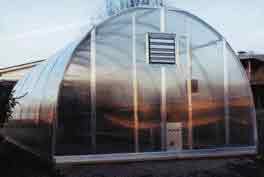
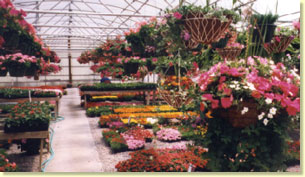 Bacterial wilt, caused by Ralstonia solanacearum race 3, biovar 2
(Ralstonia) has been found recently in greenhouse-grown
geraniums in nearby states, but not in Kentucky as of this
writing. Although not yet established in the U.S., this bacterium
can attack several crops in the field so finding it in the
greenhouse before it is accidentally moved to the field is a
serious matter.
Bacterial wilt, caused by Ralstonia solanacearum race 3, biovar 2
(Ralstonia) has been found recently in greenhouse-grown
geraniums in nearby states, but not in Kentucky as of this
writing. Although not yet established in the U.S., this bacterium
can attack several crops in the field so finding it in the
greenhouse before it is accidentally moved to the field is a
serious matter.
How the problem came about. R. solanacearum, race 3, biovar 2 has recently been introduced into U.S. greenhouses from Kenya on geranium cuttings. The initial supply came to greenhouses in Michigan and New Hampshire where they were rooted and then shipped out to greenhouses nationwide from November, 2002 - February 14, 2003. In Kentucky, potentially contaminated rooted geranium cuttings were sent to 19 greenhouses. These greenhouses are under quarantine and are being monitored by Animal Plant Health Inspection Service (APHIS) officials working from Lexington and Louisville. We have examined several plants in the U.K. plant disease diagnostic laboratory and have not yet found infected geraniums but plants with typical symptoms have not been submitted so far. The cultivars involved in this outbreak include 'Americana Dark Red', 'Americana Pink' and 'Americana Violet', shipped as rooted cuttings. Shipments of geraniums from Kenya were halted on February 14, 2003. In 1999, Ralstonia solanacearum race 3 biovar 2 was found in greenhouse geraniums in several U.S. northern and eastern states and the outbreak was contained and eliminated.
What happens if this disease is found in a greenhouse geranium crop? Growers would be required to destroy infected plants. This could involve an entire crop if the disease has spread throughout via ebb-and-flow or flood type irrigation, through improper sanitation procedures, or if cuttings or potentially diseased plants are widely distributed in the greenhouse. If only a few plants are found with Ralstonia, growers will need to rogue out the diseased plants and any other plants within a distance of one meter. This might also include other kinds of plants growing under hanging geranium baskets or otherwise commingled with geraniums. An APHIS inspector will supervise their destruction. After disinfesting the affected area using USDA-approved treatments and if no other wilted plants are observed during a proscribed holding period, the quarantine will be lifted.
Are symptoms readily visible now in the greenhouse? Geranium bacterial wilt caused by Ralstonia will be expressed under warm temperature conditions, if it is present in a plant's vascular system. In many Kentucky greenhouses temperatures for the past few months have been cool. Symptoms will appear in about 10 days if average temperatures reach about 78F (high 85, low 70), but it takes about 20 days with 70F average temperatures, and about 40 days if temperatures average 65. Aphis officials will continue monitoring the situation as temperatures warm up. In the meantime, quarantined Kentucky growers cannot move their plants.
What is Ralstonia solanacearum race 3, biovar 2 and why is it a concern? This pathogen is cited on the USDA Agricultural Bioterrorism Act of 2002 Select Agents and Toxins List, as a serious pathogen of potatoes, tomatoes, and other solanaceous plants. The present entry seems to have been an unintentional introduction of the pathogen during the routine and normal importation of geranium cuttings from Kenya by a US company. Ralstonia solanacearum, cause of bacterial wilt diseases, is a diverse and complicated microbe consisting of races determined by host ranges and biovars determined by biochemical characteristics. There are five races of R. solanacearum and only race 1, (primarily biovar 1) is currently widespread in the U.S. This pathogen causes southern bacterial wilt, a disease of field- grown crops in hotter regions of the U.S. The new bacterium, race 3 biovar 2, favored by warm, not hot temperatures, is a pathogen seriously affecting many solanaceous crops such as tomato, potato, pepper, and tobacco, thus the quarantine to keep it from being established in the U.S. The potato disease caused by this microbe is called brown rot and infections result in wilt, yellowing, stunting, and vascular browning. Races 2, 4, and 5 are not a concern just now because they exist mainly in tropical regions or in Asia.
Geranium symptoms caused by Ralstonia. The primary symptom is yellowing and wilting of leaves, followed by death of plants. The wilt may be indistinct at first and some infected plants may show marginal necrosis rather than traditional wilt as an early symptom. Older leaves usually wilt first. Growers with wilted geraniums (when the root medium is moist) should be sure to get a diagnosis of the problem. This disease could be confused with another important bacterial disease of geranium, bacterial blight, caused by Xanthomonas campestris pv. pelargonii. Wilt is also a symptom of bacterial blight, but unlike Ralstonia, X. c. pv. pelargonii causes leaf spots and only affects geranium. A laboratory diagnosis is usually needed to distinguish between these two lethal diseases.
Disease spread. The pathogen can be transmitted through soil, contaminated irrigation water, tools, equipment, or personnel. It also spreads very easily by transplanting infected plants and propagative materials. Taking cuttings without disinfecting grafting knives between plants, pinching buds of plants, and other cultural practices may facilitate the spread of the pathogen within production facilities. However, the pathogen does not readily spread from plant to plant or by the splashing of water. Spread can be controlled in greenhouses by the application of sound sanitation practices. The bacterium is not spread aerially.
Importance of the quarantine. It is very important that this
disease outbreak is contained as quickly as possible. Growers
can help by monitoring their geraniums daily and having
suspected plants diagnosed. Careful sanitation practices should
include the following: Wash hands, sterilize equipment, and if
wilted geraniums are observed, do not discard symptomatic
plants into a compost heap right away. Place these plants in
isolation and avoid handling them until a diagnosis is
confirmed. Before entering and upon leaving each greenhouse,
growers should disinfest shoes and hands and any equipment
that comes in contact with plant material. Geraniums should
not be moved or sold until it is known for sure that they are free
of this disease. There are special disposal protocols for
discarding plants with Ralstonia. USDA APHIS officials will use
a specific action plan in dealing with infected plants. Kentucky
greenhouse growers should be extremely concerned with this
disease. It is very important that all means possible be used to
contain and eradicate this disease. Additional information can
be found on the following web sites:
--Present Ralstoniaoutbreak information -
http://www.growertalks.com/ralstonia/
--Ralstoniaon geraniums photographs -
http://www.state.me.us/agriculture/pi/pseudomonas.htm
and
--USDA Bans Geraniums From Kenya Due to Ralstonia-
http://www.aphis.usda.gov/oa/pubs/sa_phgeraniums.html
--Grower newsletter article -
http://www.growertalks.com/ralstonia/ralstonia1.asp
Plants susceptible to Ralstoniasolanacearum race 3, biovar 2. The following cultivated geraniums (Pelargonium spp.) are susceptible to this new disease: Pelargonium x hortorum: zonal geranium or florist's geranium. 'Americana' geraniums fall in this group. This genus and species makes up 70-80% of the geraniums sold in the U.S. each year. Pelargonium x hortorum: seed geraniums. Pelargonium peltatum: ivy geranium. This species is typically grown in baskets (hanging above other crops which could become contaminated). Pelargonium domesticum: regal or Martha Washington geraniums. This species is grown mainly as a flowering potted crop through florists. Pelargonium spp.: scented geraniums and other novelty types with unusual flowers, foliage or scented foliage.
The following cultivated crops are susceptible: Tomato Lycopersicon esculentum, Pepper Capsicum spp., Eggplant Solanum melongena, Potato Solanum tuberosum, Bean Phaseolus vulgaris, Bitter gourd Momoridica charantia, Beet Beta vulgaris, Tobacco Nicotiana spp.
The following weeds are also potential hosts for Ralstonia: Black nightshade Solanum nigrum, Climbing nightshade Solanum dulcamara, Horse nettle Solanum carolinense, Jimson weed Datura stramonium, Purslane Portulaca oleracea, Mustards Brassica spp., Lambs quarters Chenopodium album, Bitter gourd Momoridica charantia.
[ I strongly urge all with vegetable interests to read the article by
Dr. John Hartman in this issue related to Greenhouse
Geraniums. Proper handling of this geranium situation is also
important to the state's vegetable industry.]

 Termite season is about to begin in Kentucky. During the next
several weeks, you'll probably spend more time responding to
termite calls than to any other pest problem. To complicate
matters, the public has little understanding of termites, and
what should be done if their home is infested. This column will
help you answer their questions.
Termite season is about to begin in Kentucky. During the next
several weeks, you'll probably spend more time responding to
termite calls than to any other pest problem. To complicate
matters, the public has little understanding of termites, and
what should be done if their home is infested. This column will
help you answer their questions.
Q: Why be concerned about termites?
A: Termites cause billions of dollars in damage each year. They
primarily feed on wood, but may also damage paper, books,
foam board insulation, and even swimming pool liners and
filtration systems. Termites can injure living trees and shrubs,
but usually are a secondary invader of woody plants already in
a state of decline. While a structure may become infested at any
time, presence of termites is of particular importance when
buying or selling a home since a termite inspection/infestation
report is normally a condition of sale. Besides the monetary
impact, thousands of winged termites emerging inside one's
home is an emotionally trying experience in a recent
attitudinal survey, 93 percent of Kentuckians indicated concern
about the possibility of finding termites in their home.
Q: Why are there so many termite calls during March - May?
A: Spring is typically when large numbers of winged termites,
known as "swarmers," emerge. In nature, termites swarm to
disperse and start new colonies. Triggered by warmer
temperatures and rainfall, the winged termites emerge from the
colony and fly into the air. The swarmers then drop to the
ground, shed their wings, pair off with a mate, and attempt to
begin a new colony in the soil. Few swarmers emerging
outdoors survive to start new colonies. Termite swarmers
emerging indoors are incapable of eating wood, seldom survive,
and are best removed with a vacuum cleaner. They do, however,
indicate that an infestation is present.
Q: How will I know if my home is infested?
A: The discovery of winged termites inside a home almost
always indicates an infestation warranting treatment. Termites
can be differentiated from winged ants by their straight
antennae, uniform waist and wings of equal size. (Ants have
elbowed antennae, constricted waists and forewings that are
longer than the hind wings.) Termite swarmers emerging from
tree stumps, woodpiles, and other locations out in the yard are
not necessarily cause for concern, and do not always mean that
the house is infested. On the other hand, if winged termites are
seen emerging from the base of a foundation wall or adjoining
porches and patios, there's a good chance the house is infested
also and treatment may be warranted.
Another indication of a termite problem is pencil-wide mud foraging tubes extending over foundation walls, support piers, sill plates, etc. Termites construct these mud "shelter" tubes as they travel between their underground colonies and the structure. Termite-damaged wood is usually hollowed out along the grain, with bits of dried mud or soil lining the feeding galleries. Wood damaged by moisture or other types of insects (e.g., carpenter ants) will not have this appearance.
Oftentimes there will be no sign of the termites themselves small, creamy-white insects with an ant-like appearance. An infestation can go undetected for years, hidden behind drywall, paneling, floor coverings, insulation, and other obstructions. Termite feeding and the resultant damage can even progress undetected in wood that is exposed, because the outer surface is usually left intact. Confirmation of infestation often requires the keen eye of an experienced termite inspector. However, even the most experienced inspector can overlook damage which is hidden.
Q: Can I treat the house myself?
A: Ridding a home of termites requires special skills. A
knowledge of building construction is needed to identify the
critical areas where termites are likely to enter. Many of these
potential points of entry are hidden and difficult to access.
Termite control also utilizes specialized equipment such as
masonry drills, pumps, large-capacity tanks, and soil treatment
rods. A typical treatment may involve hundreds of gallons of a
liquid pesticide, known as a termiticide, injected into the ground
alongside the foundation, beneath concrete slabs, and within
foundation walls. In short, termite treatment is usually a job for
professionals. A possible exception would be if a mailbox post,
sandbox or other small wooden object not attached to the house
was infested. "Do-it-yourself" termite baits (see bait comments
below) sold at retail stores or bought over the internet by
homeowners will seldom eradicate an existing termite problem.
Q: How do I choose a pest control company? Why is there such variance in price?
A: These are complex questions. The company should be
licensed by the Kentucky Department of Agriculture.
Membership in the Kentucky Pest Control Association and/or
National Pest Management Association suggest the company is
an established firm with access to technical and training
information needed to do the job correctly. As with any service
company, references are invaluable. Consider calling at least 2-3
companies. Requesting inspections and estimates from more
than one company will substantiate the extent of your termite
problem and allow you to compare services. Companies offer
different types of warranties or service agreements. Most offer
retreatment of localized areas if the termites return. In some
cases, no warranty/service agreement may be offered if
construction elements such as wells, cisterns, sub-slab heating
ducts, drainage systems, or inaccessible crawl spaces make it
impossible to treat in accordance with industry standards.
Take your time when selecting a company. Termites damage wood slowly; the amount of damage caused by taking an additional day, week, or month to make an informed decision is insignificant. Avoid firms that try to pressure you into signing a contract immediately with "specials" or scare tactics. Ultimately, the quality of a termite job depends less on the person who sells the job than on the individual who does the work. A safe and effective treatment requires an experienced technician, not someone who was hired a few weeks ago.
Q: Which treatments and products are most effective?
A: Another complex and difficult question. There are two
general categories of termite treatment, liquids and baits. Liquid
termiticide applications have been around for decades. Their
purpose is to provide an effective, long-lasting chemical barrier
around and beneath a structure which termites cannot breach.
Most of the products used in recent years have been repellent
rather than lethal to termites foraging in the soil. Three newer
materials, Termidor (fipronil), Premise (imidacloprid) and
Phantom (chlorfenapyr), are non-repellent. Consequently,
termites freely tunnel into the treatment zone and are killed. For
reasons too complex to explain in this article, the non-repellent
products are generally proving more reliable in their ability to
resolve termite problems in the first attempt. All registered
termiticides (both repellent and non-repellent) can be effective,
however, and homeowners should not base their purchasing
decision on product alone.
The other broad treatment category is baiting. Termite baits consist of paper, cardboard, or other "termite-friendly" food, combined with a slow-acting substance lethal to termites. Some bait materials are installed below ground out in the yard, whereas others are placed inside the structure, affixed to active termite shelter tubes. Foraging termites consume the bait and share it with their nest mates, resulting in a gradual decline in termite numbers. On some properties, baits may constitute the only form of treatment; on others, they may be supplemented with either a partial or complete liquid application to the soil.
Termite baiting is a very complex subject. A detailed discussion of the considerations in having your home treated with baits versus liquids is provided in entomology extension publications, ENT-65: Termite Baits: A Guide for Homeowners, and Entfact-644: Consumer Update: Termite Baits.
Regardless of which product or approach is selected, it's important to have an experienced technician, backed by a responsible pest control firm.
Q: Does the entire house need to be treated... or can they just "spot treat" areas where I see termites?
A: Subterranean termite colonies may contain hundreds of
thousands of individuals foraging in many different directions.
For the homeowner, localized or "spot" treatments are generally
a gamble except in cases of retreatment. Most reputable pest
control firms will not warranty spot treatments, since it's likely
that termites will eventually find other points of entry into the
structure.
Beginning this year, some companies may offer to do a somewhat more extensive "partial" treatment using one of the non-repellent liquid termiticides such as Termidor. Typically this will involve an exterior application along the foundation around the entire perimeter of the building, and spot-treatment of infested or high-risk interior areas. If the homeowner is considering such a treatment, they should inquire whether it will be accompanied by a service agreement in case termites return. (Service renewal agreements usually state that if termites return, the company will return and retreat the affected area(s) at no additional charge provided the renewal agreement is maintained.) While such treatments may be effective, it's a bit of a gamble to purchase a termite treatment without an ongoing service agreement (see final question below).
Q: How long will the treatment last?
A: All registered liquid termiticides are supposed to control
termites for at least five years when applied according to label
directions. The actual length of control on a given structure will
depend on such factors as thoroughness of the application,
prevailing environmental conditions, and density of termites in
the area. If termites swarm again and continue to be a problem
the year after treatment, it's usually not from degradation of the
termiticide but because termites have found an untreated gap
in the chemical barrier.
Q: Will the chemicals harm my family or pets?
A: Termiticides are tested extensively for adverse effects on
health. Before a product can be used, numerous studies are
conducted by the manufacturer and independently evaluated by
the U.S. Environmental Protection Agency. Based on the current
body of knowledge, registered termiticides pose no significant
hazard to humans, pets or the environment when applied
according to label directions. Despite the negligible health risk
from a properly performed termite treatment, people with
lingering concerns should consult their physician. Clients who
are still apprehensive my want to consider having their home
treated with baits.
Q: Have I been "cheated" if termites continue to infest my house after treatment?
A: Not necessarily. Unlike other services such as plumbing or
electrical work, termite control involves cryptic, living creatures.
The best treatments performed by knowledgeable firms may fail
at times, because termites are able to find their way through
tiny, untreated gaps in the soil. While the intent is to establish a
continuous, impenetrable chemical barrier in the soil, this is all
but impossible to achieve in actual practice. In the case of baits, it
may take several months for termites to initially find the bait
stations in the soil, and several months more to achieve control.
The key in termite control is to hire a reputable pest control firm
employing experienced, conscientious technicians. Companies
will usually return and retreat affected area(s) at no additional
charge provided the service agreement is purchased and
maintained.
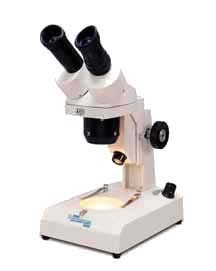
Although the winter months tend to be quiet for the Plant Disease Diagnostic Labs, we are beginning to see those signs of spring approaching--samples beginning to trickle in. Most of our recent samples have been ornamentals (greenhouse and some landscape) and have included angelonia with Pythium root rot and high soluble salts; gerbera with thrips injury; geranium and New Guinea impatiens with Botrytis blight; diplodinia with fertilizer burn; hibiscus with sooty mold; holly and inkberry with black root rot; loose leaf lettuce with injury from high greenhouse temperatures; and general over-watering problems (many plant species) in greenhouses under persistent cloudy conditions (poor evapo-transpiration).
NOTE: Trade names are used to simplify the information presented in this newsletter. No endorsement by the Cooperative Extension Service is intended, nor is criticism implied of similar products that are not named.
Lee Townsend
Extension Entomologist